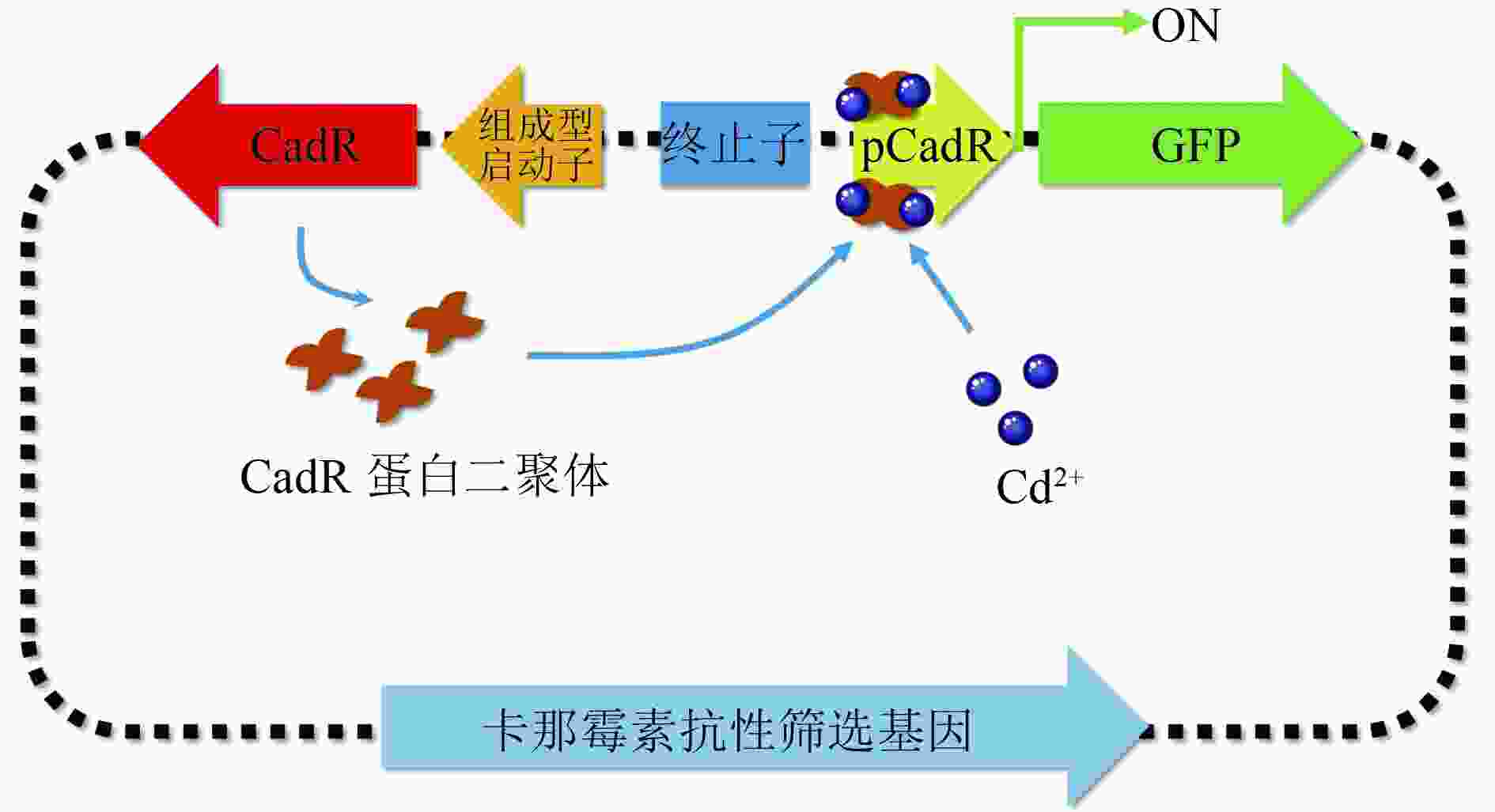Construction and optimization of cadmium-responsive bacterial biosensor based on CadR
-
摘要:
以镉调控蛋白(cadmium resistance protein, CadR)为检测元件、绿色荧光蛋白为报告元件构建镉离子细菌生物传感器检测水体样品中的重金属镉,通过单因素试验和正交试验对检测条件进行优化以提升传感器的相对荧光强度,基于最优组合使用所构建的镉细菌生物传感器对加标长江水样进行检测。结果表明:所构建的重金属镉细菌生物传感器在0~200 μg/L浓度范围内对镉的荧光响应符合剂量依赖效应;单因素试验结果表明,温度、pH、诱导时间以及阳离子对镉生物传感器的灵敏度有显著影响,而通过改变不同阴离子配体对检测结果并未产生显著影响;正交试验优化结果显示,镉细菌生物传感器的最优检测条件组合为:温度为37 ℃,pH为7,诱导时间为120 min,添加终浓度为50 μg/L的Mg2+,在此条件下传感器响应镉的相对荧光强度相较于优化前增强了1.6倍;使用该传感器对加标长江水样检测结果显示,其对于0~500 μg/L的环境水样中的镉具有较好的检测能力,荧光响应最大值达到背景值的20倍。
Abstract:Using cadmium responsive protein (CadR) as detection element and green fluorescent protein as report element, a cadmium-responsive bacterial biosensor was constructed to detect heavy metal cadmium in water samples. Single factor experiment and orthogonal test for detection condition optimization were applied to improve the relative fluorescence intensity of the biosensor. Finally, the spiked Yangtze River water samples was detected with the constructed cadmium-responsive bacterial biosensor based on the given optimal combination. The results showed that the fluorescence response of the biosensor to cadmium in the concentration range of 0-200 μg/L conformed to the dose-dependent effect. The single-factor test showed that temperature, pH, induction time and cations had significant effects on the sensitivity of cadmium-responsive biosensor, while different anion ligands had no significant effect on the detection results. The orthogonal test showed that the optimal detection conditions for cadmium-responsive bacteria biosensor were as follows: temperature 37 ℃, pH 7, induction time 120 min, and adding Mg2+ with final concentration of 50 μg/L. The verifying experiment indicated that under the optimal combination condition, the fluorescence response of the biosensor to the same concentration of cadmium increased by 1.6 times. The detection results of the spiked Yangtze River water samples by the sensors showed their high performance in detecting cadmium in 0-500 μg/L environmental water samples, and the maximum fluorescence output reached 20 times of the background.
-
Key words:
- heavy metal /
- cadmium /
- bacterial biosensor /
- cadmium-responsive protein /
- performance optimization
-
表 1 镉响应表达质粒构建相关引物
Table 1. Primers used for the construction of cadmium-responsive expression plasmid
引物名称 序列(5′→3′) F-CadR TCAGTACTATGAAGATCGGTGAGCTGGC R-CadR TCCAGGATCCTCAGCCATGCCGGCG F-pCadR TAGTCGACGCCAACCCTCCTCCAATCG R-pCadR TAAGATCTCAGGGTTCCGATGGCGG 表 2 镉细菌生物传感器检测条件优化正交试验因素与水平
Table 2. Orthogonal test factors and levels for optimization of detection conditions of cadmium-responsive bacterial biosensor
水平 温度/℃ pH 诱导时间/min 阳离子 1 37 4 30 Mg2+ 2 26 7 60 Na+ 3 16 11 120 Ca2+ 表 3 镉生物传感器检测条件优化正交试验结果与分析
Table 3. Results and analysis of orthogonal test for optimizing detection conditions of cadmium-responsive biosensor
试验号 温度/℃ pH 诱导时间/min 阳离子 相对荧光
强度/倍1 37 4 30 Mg2+ 1.56 2 37 7 60 Na+ 3.75 3 37 11 120 Ca2+ 5.10 4 26 4 60 Ca2+ 1.57 5 26 7 120 Mg2+ 3.04 6 26 11 30 Na+ 1.77 7 16 4 120 Na+ 1.74 8 16 7 30 Ca2+ 1.88 9 16 11 60 Mg2+ 1.39 k1 3.47 1.62 1.74 2.00 k2 2.13 2.89 2.23 2.42 k3 1.67 2.75 3.29 2.85 R 1.80 1.27 1.55 0.85 最优水平 1 2 3 3 主次因素 温度>诱导时间>pH>阳离子 最优组合 温度为37 ℃,pH为7,诱导时间为120 min,
添加50 μg/L Mg2+ -
[1] VARAGIYA D, JETHVA B, PANDYA D. Feather heavy metal contamination in various species of waterbirds from asia: a review[J]. Environmental Monitoring and Assessment,2022,194(1):1-14. doi: 10.1007/s10661-021-09612-y [2] 曾晨, 郭少娟, 杨立新.汞、镉、铅、砷单一和混合暴露的毒性效应及机理研究进展[J]. 环境工程技术学报,2018,8(2):221-230. doi: 10.3969/j.issn.1674-991X.2018.02.030ZENG C, GUO S J, YANG L X. Toxic effects and mechanisms of exposure to single and mixture of mercury, cadmium, lead and arsenic[J]. Journal of Environmental Engineering Technology,2018,8(2):221-230. doi: 10.3969/j.issn.1674-991X.2018.02.030 [3] 杜丽娜, 余若祯, 王海燕, 等.重金属镉污染及其毒性研究进展[J]. 环境与健康杂志,2013,30(2):8. doi: 10.16241/j.cnki.1001-5914.2013.02.020DU L N, YU R Z, WANG H Y, et al. Pollution and toxicity of cadmium: a review of recent studies[J]. Journal of Environment and Health,2013,30(2):8. doi: 10.16241/j.cnki.1001-5914.2013.02.020 [4] HE M Y, LIN Y J, KAO Y L, et al. Sensitive and specific cadmium biosensor developed by reconfiguring metal transport and leveraging natural gene repositories[J]. Acs Sensors,2021,6(3):995-1002. doi: 10.1021/acssensors.0c02204 [5] 林巧丽, 姚永峰.水中铜、锌、铅、镉检测方法的研究进展[J]. 山东化工,2018,47(16):3. doi: 10.3969/j.issn.1008-021X.2018.16.003LIN Q L, YAO Y F. Pollution and toxicity of cadmium: a review of recent studies[J]. Shandong Chemical Industry,2018,47(16):3. doi: 10.3969/j.issn.1008-021X.2018.16.003 [6] 秦伟彤, 田健, 伍宁丰.全细胞生物传感器的设计及其在环境监测中的应用[J]. 生物技术进展,2018,8(5):369-375. doi: 10.19586/j.2095-2341.2018.0044QIN W T, TIAN J, WU N F. Design of the whole-cell biosensor and its application in environmental monitoring[J]. Current Biotechnology,2018,8(5):369-375. doi: 10.19586/j.2095-2341.2018.0044 [7] ZHANG X, LI B, SCHILLEREFF D N, et al. Whole-cell biosensors for determination of bioavailable pollutants in soils and sediments: theory and practice[J]. Science of the Total Environment,2022,811:152-178. [8] 劳昌玲, 罗立强, 沈亚婷, 等.微生物与重金属相互作用过程与机制研究进展[J]. 环境科学研究,2020,33(8):1929-1937. doi: 10.13198/j.issn.1001-6929.2019.12.06LAO C L, LUO L Q, SHEN Y T, et, al. Interaction process and mechanism of microorganisms and heavy metals: a review[J]. Research of Environmental Sciences,2020,33(8):1929-1937. doi: 10.13198/j.issn.1001-6929.2019.12.06 [9] NIES D H. The cobalt, zinc, and cadmium efflux system CzcABC from Alcaligenes eutrophus functions as a cation-proton antiporter in Escherichia coli[J]. Journal of Bacteriology,1995,177(10):2707-2712. doi: 10.1128/jb.177.10.2707-2712.1995 [10] HUI C Y, GUO Y, LI L M, et al. Indigoidine biosynthesis triggered by the heavy metal-responsive transcription regulator: a visual whole-cell biosensor[J]. Applied Microbiology and Biotechnology,2021,105(14/15):6087-6102. [11] HUI C Y, GUO Y, WU J, et al. Detection of bioavailable cadmium by double-color fluorescence based on a dual-sensing bioreporter system[J]. Frontiers in Microbiology,2021,12:1915. [12] JIA X Q, LIU T, MA Y, et al. Construction of cadmium whole-cell biosensors and circuit amplification[J]. Applied Microbiology and Biotechnology. 2021, 105(13): 5689-5699. [13] 侯启会, 马安周, 庄绪亮, 等.微生物全细胞传感器在重金属生物可利用度监测中的研究进展[J]. 环境科学,2013,34(1):347-356. doi: 10.13227/j.hjkx.2013.01.013HOU Q H, MA A Z, ZHUANG X L, et al. Advance in the bioavailability monitoring of heavy metal based on microbial whole-cell sensor[J]. Environmental Science,2013,34(1):347-356. doi: 10.13227/j.hjkx.2013.01.013 [14] 窦敏娜.微生物细胞传感器在环境监测中应用进展[J]. 陕西农业科学,2018,64(10):96-99. doi: 10.3969/j.issn.0488-5368.2018.10.029DOU M N. Advance of application of microbial cell sensors in environmental monitoring[J]. Shaanxi Journal of Agricultural Sciences,2018,64(10):96-99. doi: 10.3969/j.issn.0488-5368.2018.10.029 [15] 贺莹, 王学江, 王虹, 等.Cellsense生物传感器毒性分析系统应用研究[J]. 生态毒理学报,2009,4(1):108-113.HE Y, WANG X J, WANG H, et al. The application performance of cellsense biosensor for toxicity assessment[J]. Asian Journal of Ecotoxicology,2009,4(1):108-113. [16] KIM Y, CHOI H, SHIN W H, et al. Development of colorimetric whole-cell biosensor for detection of heavy metals in environment for public health[J]. International Journal of Environmental Research and Public Health,2021,18(23):12721. doi: 10.3390/ijerph182312721 [17] LI P, WANG Y, YUAN X, et al. Development of a whole-cell biosensor based on an ARSR-P-ARS regulatory circuit from geobacter sulfurreducens[J]. Environmental Science and Ecotechnology,2021,6:100092. doi: 10.1016/j.ese.2021.100092 [18] 温国霞, 黄子豪, 谭俊杰, 等.以大肠杆菌为底盘细胞构建XylR-Pu线路检测2, 4, 6-三硝基甲苯[J]. 中国生物工程杂志,2017,37(7):105-114.WEN G X, HUANG Z H, TAN J J, et al. Construction of XylR-Pugene lines in Escherichia coli to detect 2, 4, 6-trinitrotoluene[J]. China Biotechnology,2017,37(7):105-114. [19] ELCIN E, ÖKTEM H A. Inorganic cadmium detection using a fluorescent whole-cell bacterial bioreporter[J]. Analytical Letters, 2020, 53(17): 2715-2733. [20] POLA-LÓPEZ L, CAMAS-ANZUETO J, MARTÍNEZ-ANTONIO A, et al. Novel arsenic biosensor "pola" obtained by a genetically modified E. coli bioreporter cell[J]. Sensors and Actuators B: Chemical, 2018, 254: 1061-1068. [21] ZHANG Y, TIAN J, LI K, et al. Label-free visual biosensor based on cascade amplification for the detection of salmonella[J]. Analytica Chimica Acta,2019,1075:144-151. doi: 10.1016/j.aca.2019.05.020 [22] JIA X Q, LIU T, MA Y B, et al. Construction of cadmium whole-cell biosensors and circuit amplification[J]. Applied Microbiology and Biotechnology,2021,105(13):5689-5699. doi: 10.1007/s00253-021-11403-x [23] LI L Z, LIANG J T, HONG W, et al. Evolved bacterial biosensor for arsenite detection in environmental water[J]. Environmental Science & Technology,2015,49(10):6149-6155. [24] 刘社际, 葛永红, 杨立明.培养温度对基因工程菌生长密度和RHG-CSF表达的影响[J]. 中国生物制品学杂志,1999(1):29-31. doi: 10.13200/j.cjb.1999.01.29.liushj.013LIU S J, GE Y H, YANG L M. Influence of culture temperature on growth density of recombinant bacterial strain and expression of rhG-CSF[J]. Chinese Journal of Biologicals,1999(1):29-31. doi: 10.13200/j.cjb.1999.01.29.liushj.013 [25] 王丽, 陈炎, 于超, 等.pH胁迫提高微生物次级代谢产物合成的研究进展[J]. 齐鲁工业大学学报,2021,35(4):20-25. doi: 10.16442/j.cnki.qlgydxxb.2021.04.004WANG L, CHEN Y, YU C, et al. Recent progress on the improvement of microbial secondary metabolite synthesis by pH stress[J]. Journal of Qilu University of Technology,2021,35(4):20-25. doi: 10.16442/j.cnki.qlgydxxb.2021.04.004 [26] 陈学敏.pH对大肠杆菌生存的影响[J]. 环境卫生学杂志,1975(5):287-288. [27] 吴燕, 刘志红.小分子物质跨膜转运和离子通道的基础[J]. 肾脏病与透析肾移植杂志,1996(5):40-44. ⊗ -





 下载:
下载:










